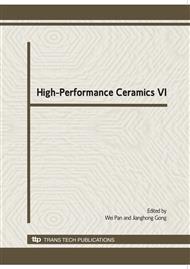[1]
P. Ettmayer, H. Kolaska, W. Lengauer, et al.: J. Int. Refract. Met. Hard Mater. Vol. 13 (1995), p.343.
Google Scholar
[2]
T. Viatte, S. Bolognini, T. Cutard, et al.: J. Int. Refract. Met. Hard Mater. Vol. 17 (1999) , p.79.
Google Scholar
[3]
G. E. D'Errico, S. Bugliosi, D. Cuppini, et al.: J. Wear. Vol. 204 (1997) , p.242.
Google Scholar
[4]
S. Bolognini and G. Feusier: J. Int. Refract. Met. Hard Mater. Vol. 16 (1998) , p.257.
Google Scholar
[5]
G. Straffelini, D. Colombo and A. Molinari: J. Wear. Vol. 236 (1999), p.179.
Google Scholar
[6]
A. Grosjean, M. Rezrazi, U.J. Takadoum, et al.: J. Surf. Coat. Technol. Vol. 130 (2000) , p.252.
Google Scholar
[7]
A.A. Khan and J.C. Labble: J. Eur. Ceram. Soc. Vol. 17 (1997) , p.1885.
Google Scholar
[8]
S. Vives, C. Guiazard, L. Cot, et al.: J. Mater. Sci. Vol. 34 (1999) , p.3127.
Google Scholar
[9]
T. Sekino, T. Nakajima, S. Ueda, et al.: J. Am. Ceram. Soc. Vol. 80 (1997) , p.1139.
Google Scholar
[10]
O.H. Sung-Tag, S. Mutsuo and N. Koichi: J. Mater. Sci. Vol. 36 (2001) , p.1817.
Google Scholar
[11]
G.Z. Zou, M.S. Cao, H.B. Lin, et al.: J. Powder Technol. Vol. 168 (2006) , p.84.
Google Scholar
[12]
H.J. Zhang, X.W. Wu, Q.L. Jia, et al.: J. Mater. Des. Vol. 28 (2007) , p.1369.
Google Scholar
[13]
W.B. He, B.L. Zhang , H.R. Zhuang, et al.: J. Ceram. Int. Vol. 31 (2005) , p.811.
Google Scholar
[14]
I. -H. Oh, J. -Y. Lee, J.K. Han, et al., Surf. Coat. Technol. Vol. 192 (2005) , p.39.
Google Scholar
[15]
G.P. Ling, C. Zhang, J.H. He, Mater.: J. Lett. Vol. 58 (2003) , p.200.
Google Scholar
[16]
G. Wen, Z.X. Guo, C.K.L. Davies: J. Scripta mater. Vol. 43 (2000) , p.307.
Google Scholar
[17]
D.K. Simpson: J. MetalFinish. Vol. 83 (1985) , p.57.
Google Scholar
[18]
B.G. Bagley and D. Turnbull: J. Acta Metall. Vol. 18 (1970) , p.857.
Google Scholar
[19]
D.T. Gawne and U. Ma: J. Mater. Sci. Technol. Vol. 3 (1987) , p.228.
Google Scholar
[20]
P.H. Lo, W.T. Tsai, J.T. Lee, et al.: J. Scr. Metall. Mater. Vol. 29 (1993) , p.37.
Google Scholar
[21]
Y. Azumi, T. Yugirl, T. Kurihara, et al.: J. Electrochem. Soc. Vol. 150 (2003) , p.461.
Google Scholar
[22]
P.H. Lo, W.T. Tsai and J.T. Lee: J. Electrochem. Soc. Vol. 137 (1990) , p.1056.
Google Scholar
[23]
S.H. Park and D.N. Lee: J. Mater. Sci. Vol. 23 (1988) , p.1643.
Google Scholar


